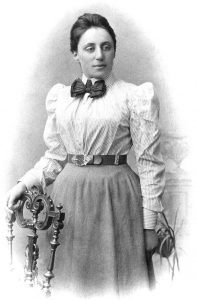 In a previous post (Mathematics in times of anger) I explained how Ludwig Bieberbach set himself up as the main ideologue of mathematical Nazism and how he accused German mathematical journals of, among other things, dedicating articles to Jewish and communist women. Bieberbach’s attack was directed in particular against Emmy Noether (1882-1935).
In a previous post (Mathematics in times of anger) I explained how Ludwig Bieberbach set himself up as the main ideologue of mathematical Nazism and how he accused German mathematical journals of, among other things, dedicating articles to Jewish and communist women. Bieberbach’s attack was directed in particular against Emmy Noether (1882-1935).
Noether was one of the great protagonists of the process of abstraction of algebra in the first decades of the 20th century, and also the author of a profound theorem on the intimate connections between the mathematical symmetries of physical laws and the existence of associated quantities that remain invariant.
Noether was born in Erlangen in 1882. A few decades earlier, the ban on women attending university had begun to change in Europe. Women had been allowed to enter universities in France since 1861, in England since 1878, and in Italy since 1885. Germany took somewhat longer; there were voices particularly critical of equality there: “Many sensible men talk of surrendering our universities to the invasion of women, thus falsifying the distinctive character of these institutions,” wrote an eminent historian at the time. “It is a disgraceful display of moral weakness which only responds to the loud demands of the press. The intellectual weakness of such a position is incredible because universities are much more than mere institutions where science and scholarship are taught. It is in the very nature of small universities to provide students with an atmosphere of camaraderie of inestimable value in building the character of a young man”.
Nevertheless, in 1900 Emmy Noether was allowed to study as an audition student at the University of her hometown. Although she could not, in principle, take her exams – the university officials thought that anything else would disrupt the academic order of the house. At that time there were two women among almost a thousand male students. After a year in Göttingen, Noether returned to Erlangen in 1904, once women were allowed to take exams. After receiving her doctorate, she taught there, but without a salary.
In 1915, Noether went to Göttingen to work with David Hilbert, one of the few advocates of the full integration of women at the university. There and in those years she proved her theorem on symmetry and invariance; and there, too, the years passed without her being allowed to teach, despite Hilbert’s efforts, despite the overwhelming logic he used to defend Noether’s right to teach: “I don’t see why the sex of the candidate is an argument against her appointment as a professor,” he once said. “After all, we are a university and not a bathing establishment”. While Hilbert was saying this, other professors, just after the First World War, argued: “Should the soldiers, returning from the discipline and hardships of war, now find themselves in the classroom under the authority of a woman?” It was not until 1923 that Emmy Noether got an appointment as an unofficial associate professor; and Richard Courant (1888-1972), then director of the Mathematical Institute, had a hard time getting Noether paid for her work; it was meagre, but at least regular.
A celebrated French mathematician said about this woman: “She was the best mathematician of her time, and one of the best mathematicians (without distinction of sex) of the 20th century”; a no less well-known one, a Dutchman in this case and a pupil of Noether, wrote: “That she was such an exceptional person was not the exclusive consequence of her exceptional mathematical talent, but rather of her personal creativity seen as a whole, her way of thinking and her strength of determination”; Einstein called her “the most important and significant creative genius that mathematics has produced since women were allowed access to higher education”; and Hermann Weyl (1885-1955), Hilbert’s most distinguished disciple, requested a better position for her when he took up a professorship in Göttingen in 1930: “I was ashamed to occupy a privileged position in front of Emmy Noether, because I knew that she was, as a mathematician, superior to me in many respects. Tradition, prejudices, considerations outside the scientific sphere, tipped the balance against Emmy’s greatness and scientific merits. In my years in Göttingen (1930-33), she formed the strongest centre of mathematical activity, whether we consider the fertility of her scientific research or her influence on a wide circle of disciples”.
Bieberbach accused Noether of being a communist simply because she had won the scientific admiration of a large part of the then very important Russian mathematical school based in Moscow. Its leader, Pavel Alexandrov, said of her: “Emmy Noether was the greatest of women mathematicians, the creator of one of the most brilliant mathematical schools in Europe, a great scientist, a magnificent teacher and an unforgettable person. Emmy loved people, science and life with all the fervour, joy, generosity and affection with which a deeply sensitive (and feminine) soul is capable”. The mathematical community recognised Emmy Noether’s merits by inviting her to give lectures at the International Congresses in Bologna (1928) and Zurich (1932).

But in 1933, a year after receiving the consideration of the mathematicians in Zurich, Emmy Noether was expelled from Göttingen after Hitler’s application of the racial laws. She decided to head for exile. Her Russian friends tried to create a position for her in Moscow, but Soviet authorities refused. Through the Rockefeller Foundation, Noether got a job at the University of Bryn Mawr, a small town in Pennsylvania, at the end of 1933; it was a somewhat precarious position, but she accepted it, aware that, at the age of 50 and as a woman, her situation was very difficult. She died in 1935.
It follows from Noether’s famous theorem on symmetry and invariance that invariance with respect to translations and rotations gives rise to the laws of conservation of linear and angular momentum, respectively, and invariance with respect to time gives rise to the law of conservation of energy. Noether’s theorem has allowed physicists to sharpen their insight into the fundamental conservation laws. “The idea that the conservation of energy is a fundamental principle did not emerge until the middle of the 19th century,” wrote physics Nobel laureate Frank Wilczek (1951-). And even then, why it should hold true was a complete mystery, until Noether’s discovery. Even today I don’t think we have got to the bottom of it. And also: “Noether’s theorem, by connecting the conservation laws with simple qualitative aspects of physical reality, offers a profound insight into why these laws exist. At the frontiers of modern physics, Noether’s theorem has become an essential tool of discovery”.
References
Antonio J. Durán, Pasiones, piojos, dioses… y matemáticas, Destino, Barcelona, 2009.

Leave a Reply